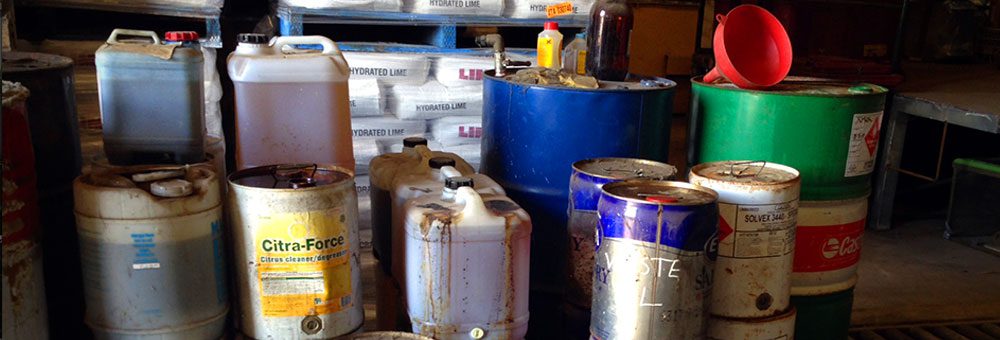Exactly How Liquid Garbage Disposal Functions: An In-depth Summary of Techniques and Technologies Used

Summary of Liquid Waste Kind
The intricacy of fluid waste kinds necessitates a complete understanding of their features and effects for disposal. Fluid waste can extensively be classified into numerous kinds, consisting of industrial, municipal, agricultural, and dangerous waste. Each category exhibits distinctive properties, requiring particular management strategies to minimize ecological and health risks.
Industrial liquid waste stems from producing processes and often has a variety of contaminants, such as hefty metals, solvents, and natural substances. Community liquid waste, primarily consisting of wastewater from homes and commercial facilities, consists of raw material, nutrients, and microorganisms (industrial wastewater treatment). Agricultural liquid waste, consisting of runoff from ranches, may include plant foods, pesticides, and pet waste, posing threats to water high quality and ecosystems
Unsafe liquid waste is characterized by its toxicity, sensitivity, or potential to trigger damage. Recognizing these varied fluid waste kinds is vital for creating reliable disposal approaches and making certain conformity with ecological laws.
Physical Therapy Techniques

Testing is the first step, where bigger bits and debris are removed from the liquid waste making use of displays or grates. In sedimentation tanks, much heavier particles clear up at the bottom, forming a sludge layer, while the cleared up fluid can be more treated.
Purification is one more important method that includes passing the liquid via porous materials, such as sand or membrane layers, to record smaller bits. This step boosts the high quality of the liquid, making it ideal for subsequent therapy processes.

Chemical Therapy Methods
Chemical treatment methods are essential for successfully managing fluid waste, especially in dealing with liquified and colloidal impurities that physical techniques might not properly get rid of. These methods make use of various chemical agents to counteract, precipitate, or transform harmful materials into less unsafe forms.
One typical method is coagulation and flocculation, where chemicals such as alum or ferric chloride are included to promote the aggregation of suspended fragments. This procedure enhances sedimentation, permitting easier removal of the resulting sludge. Furthermore, oxidation procedures, using representatives like chlorine or ozone, are employed to break down complex organic compounds and virus, providing the waste more secure for discharge or further treatment.
Neutralization is another important strategy, which readjusts the pH of acidic or alkaline waste streams to neutral degrees, preventing potential harm to downstream systems and the environment. Additionally, advanced oxidation processes (AOPs) use combinations of oxidants and ultraviolet light to deteriorate consistent contaminants, accomplishing a higher level of treatment efficiency.
Biological Treatment Procedures
Organic therapy procedures play a critical duty in the monitoring of fluid waste by using microorganisms to decompose organic issue and lower impurity degrees. These processes can be broadly categorized right into anaerobic and cardiovascular treatments, each employing specific microbial areas to attain efficient waste deterioration.
Aerobic therapy entails making use of oxygen to help with the break down of natural products by germs. This process is generally applied in triggered sludge systems, where aeration containers supply a conducive environment for microbial development, resulting in the oxidation of organic toxins. The resultant biomass can be separated from dealt with effluent with sedimentation.
On the other hand, anaerobic therapy happens this page in the lack of oxygen, depending on different microorganisms to break down natural matter. This approach is especially beneficial for high-strength waste, as it creates biogas, a renewable resource source, while reducing sludge manufacturing. Technologies such as anaerobic digesters are frequently utilized in industrial and local applications.
Both anaerobic and aerobic biological therapies not just lessen the ecological effect of fluid waste however additionally help with source recovery, making them necessary components of lasting waste management techniques. click this Their flexibility, efficiency, and effectiveness support their prevalent execution across various markets.
Arising Technologies in Disposal
Cutting-edge approaches to liquid garbage disposal are swiftly progressing, driven by advancements in technology and a boosting focus on sustainability. Amongst these arising modern technologies, membrane bioreactors (MBRs) have gained traction for their ability to integrate biological therapy with membrane layer purification, causing high-quality effluent that can be reused in various applications. MBRs enable smaller footprints and more efficient operations contrasted to typical systems.
An additional encouraging growth is making use of anaerobic food digestion incorporated with nutrient healing innovations, which not only treats liquid waste but additionally creates biogas and recoups useful nutrients industrial wastewater treatment solutions like nitrogen and phosphorus. This double advantage enhances resource effectiveness and reduces ecological impact.
Furthermore, progressed oxidation procedures (AOPs) are being taken on for the deterioration of complex natural pollutants. These methods utilize powerful oxidants and stimulants to break down pollutants at the molecular degree, using a very efficient option for tough waste streams.
Moreover, the integration of fabricated intelligence and artificial intelligence in waste monitoring systems is enhancing operational effectiveness and predictive maintenance, resulting in reduced expenses and boosted environmental conformity. These modern technologies reflect a substantial shift towards even more lasting and efficient liquid waste disposal practices.
Verdict
To conclude, efficient liquid waste disposal necessitates an extensive understanding of different techniques and modern technologies. The integration of physical, chemical, and biological therapy approaches makes certain the reliable monitoring of varied waste types. Additionally, the appearance of cutting-edge technologies enhances treatment efficacy and promotes sustainability in waste management practices. By continually progressing these methodologies, it ends up being possible to address the expanding challenges connected with liquid waste, inevitably adding to environmental management and resource healing.
Fluid waste disposal is an important facet of environmental management, requiring a detailed understanding of numerous methods and technologies tailored to various waste types. Liquid waste can generally be categorized right into numerous kinds, including commercial, local, agricultural, and unsafe waste. Agricultural fluid waste, including drainage from ranches, might include fertilizers, pesticides, and pet waste, posing threats to water quality and communities.
Various physical therapy methods play a critical function in handling fluid waste successfully - industrial wastewater treatment.In final thought, effective fluid waste disposal demands an extensive understanding of various methods and innovations